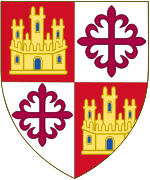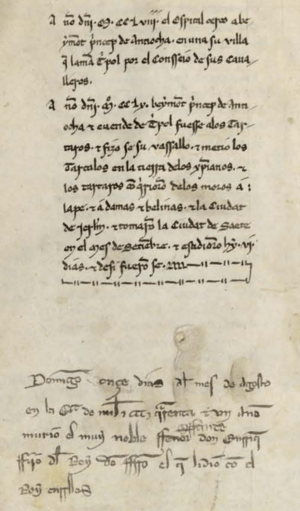Henry of Castile the Senator facts for kids
Quick facts for kids Henry of Castile |
|
|---|---|

Arms of Infante Henry of Castile.
|
|
| Born | March 1230 |
| Died | 8 August 1303 (aged 73) |
| Burial | Monastery of San Francisco, Valladolid |
| Spouse | Juana Núñez de Lara |
| Issue | Enrique Enríquez de Sevilla (illegitimate) |
| House | Castilian House of Ivrea |
| Father | Ferdinand III of Castile |
| Mother | Elisabeth of Swabia |
Henry of Castile (born March 1230 – died August 8, 1303) was a prince from the Castilian royal family. He was known as the Senator (el Senador). Henry was the fourth son of King Ferdinand III of Castile and his first wife, Beatrice of Swabia. His life was full of adventures, including rebellions, travels, and even a long time in prison.
Contents
Early Life and Royal Challenges
Henry grew up in Burgos, a city in Spain. He received a good education, learning about both fighting and books, as was common for a royal prince.
In 1246, Henry joined his father on a military trip to Jaén. His father gave him control over newly conquered towns like Morón de la Frontera and Cote. After the city of Seville was captured, Henry received even more towns, including Jérez de la Frontera and Medina Sidonia. He spent several years in Seville, often at the court of his father's second wife.
After his father died in 1252, Henry and his brother Frederick became unhappy with the rule of their older brother, Alfonso X. In 1253, King Alfonso took away some special rights that Henry had been given. He also stopped Henry from making a good marriage.
Rebellion and Escape from Castile
These problems led Henry to plan against King Alfonso. In 1255, Henry openly rebelled, gaining support from some powerful lords. Even though he won an early battle, he was eventually defeated near Morón.
Henry had to leave Spain. He sailed from Cádiz through the Mediterranean Sea, stopping in Valencia. He then traveled through France, seeking safety with his stepmother. She might have suggested he visit his half-sister Eleanor, who was married to Edward, the son of King Henry III of England.
Life in England
Henry arrived at the English royal court in mid-1256. He lived comfortably there for three years, thanks to King Henry III. However, the English king did not offer him political help.
In 1257, an ambassador from Pope Alexander IV came to England. Henry offered to lead soldiers to Italy to help the English king's son, Edmund, conquer the Kingdom of Sicily. But a rebellion in Wales stopped these plans.
After trying to find support in France without success, Henry decided to seek his fortune in Africa. He went to Tunis, where the Hafsid ruler, Muhammad al-Mustansir, had built a large empire. In July 1259, the King of England allowed Henry to leave for Tunisia.
Adventures in Tunisia
Henry first sailed to Catalonia, but the local king did not allow his knights to join Henry's trip to Tunisia. In 1260, Henry arrived in Tunis, where his brother Frederick soon joined him. Henry took charge of a group of Spanish knights who served the ruler al-Mustansir.
In 1261, Henry led an attack on the city of Miliana. These military actions helped the Hafsid rulers stay independent from other powerful groups. In Tunis, Henry adopted some of the local customs and clothing. He used the money he earned to start trading businesses with merchants from Genoa.
Becoming the Senator in Italy
Later, Henry traveled to Italy. He joined his cousin Charles of Anjou's military campaign in 1266. Charles wanted to become the King of Sicily. Henry lent Charles a lot of money to help him.
It was during this time that Henry earned his nickname, El Senador. Charles of Anjou made him the senator of Rome. At that time, the senator was a powerful leader in the city of Rome. However, Charles never paid Henry back the money he owed. Henry had hoped for a higher title, like the kingship of Sardinia, so being a senator felt like a small reward.
Because he was unhappy, Henry changed sides in 1268. He joined his other cousin, Conradin, who was invading Italy. Henry became one of Conradin's generals at the Battle of Tagliacozzo. He led three hundred Spanish knights. Henry won the first part of the battle, but he was defeated by a surprise attack from Charles of Anjou's hidden French knights. After losing the battle, Henry fled to a monastery, where he was captured.
Years in Prison
Henry spent the next twenty-three years as a prisoner. He was held in the castle of Canosa and later in Castel del Monte.
In 1272, his half-sister Eleanor and her husband, King Edward I of England, visited Sicily while returning from the Crusades. Eleanor tried to get Henry released from prison, but she was not successful. She continued to stay in touch with him until she died.
Henry was finally released from prison in 1291. He returned to Castile in 1298. There, he was chosen to be a regent for his grandnephew, King Ferdinand IV. This meant he helped rule the country because the king was still young. Henry married Juana Núñez de Lara, but they did not have any known children. He died in 1303.
Other Stories About Henry
It is said that Henry had a son outside of marriage with a woman named Mayor Rodríguez Pecha. This son was called Enrique Enriquez de Sevilla. He later became a very important judge in Castile.
Some recent studies suggest that the famous knightly story "Amadis de Gaula" might have been written by Henry of Castile.
See also
 In Spanish: Enrique de Castilla el Senador para niños
In Spanish: Enrique de Castilla el Senador para niños


